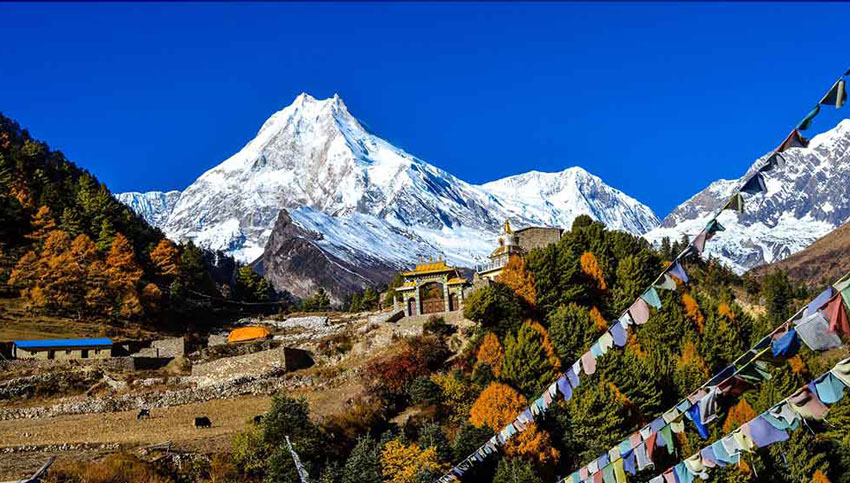Manaslu Trekking – Best and Worst Time to Trek
Manaslu Trekking is a life-changing experience that offers a combination of natural beauty, cultural richness and adventure. The trail takes you through several villages like Sho, Lho and Shyala.
The trek remains remote despite its rising popularity compared to other teahouse treks in Nepal. The hike includes breathtaking views of peaks including Mt. Manaslu, the world’s eighth highest peak.
Weather
The weather conditions at the Manaslu circuit trek can affect your trekking experience. For this reason, you must carefully choose the right time for this expedition. To help you, we have listed the best and worst times to make your decision easier.
Spring (March-May): The flora and vegetation are in full bloom during this season, which gives the trails a heavenly ambiance. The temperatures are warm and pleasant during this period.
Autumn (October-November): The days become clear and sunny, making the views of the mountains more vibrant. Also, the weather is stable during this period.
Winter (December-February): This is a challenging time to trek as the snowfall can hinder your movement on the trail. Moreover, the temperatures can drop below freezing point. Nevertheless, if you are equipped with the required winter gear, you can successfully complete this expedition. However, this is not a recommended time for first-timers. This is because the trail may be closed due to heavy snowfall.
Altitude Sickness
The Manaslu trek is a thrilling adventure that requires a lot of physical and mental preparation. It can be challenging for those who are not well-trained to tackle the long hours of hiking and high altitudes. However, the stunning landscape of cascading waterfalls, lush green forests, and snow-capped peaks will make your journey worthwhile.
During the hike, you will reach high altitudes that can cause altitude sickness. The symptoms of altitude sickness can vary from headaches to nausea, tiredness, and difficulty sleeping. It can also lead to more serious conditions like acute mountain sickness or high altitude pulmonary edema.
To prevent altitude sickness, it is important to follow the acclimatization steps mentioned below. This will help your body adjust to the lower oxygen levels at higher elevations and minimize the risk of altitude sickness. You can also do some training before your trek to build up your stamina. Doing exercises such as cardio and strength training will prepare your body for the long hikes and high altitudes of the Manaslu circuit trek.
Equipment
A quality backpack is a necessity for Manaslu Trekking. It should be lightweight and waterproof, with space for sleeping bags and other equipment. It should also be fitted with comfortable straps and padding to minimize back strain. Similarly, hiking poles are important for stability and can reduce the stress on the knees during descent.
A guide is crucial for the safety and well-being of trekkers. A trained and experienced guide will be able to navigate the rugged terrain and provide first aid in case of an emergency. Additionally, they can provide valuable information about the local culture and history of the region.
Physical preparation is important for the Manaslu Circuit trek, as it will get your body accustomed to the altitude. Practicing daily exercises and training at lower elevations will improve the circulation of oxygen in your body, which will help prevent altitude sickness. In addition, you should consult with a doctor to ensure that you are healthy enough for the trek.
Safety
The Manaslu Circuit trek is considered a moderate to challenging trekking experience, due to the long hours of hiking and the altitude. It is important to prepare for the trek by engaging in regular physical activity, such as cardio and strength training. It is also advisable to practice walking with a backpack to simulate the conditions on the trek.
The best time to hike the Manaslu Circuit is in spring and autumn, when the weather is dry and clear. However, it is possible to trek during the monsoon season (June to August) and winter as well. These seasons may have occasional snowfall and rainstorms at higher elevations.
It is important to carry a first aid kit, as well as a map and compass. Moreover, it is advisable to travel with an experienced guide for safety and convenience. A guide will also be able to provide information about the local culture and customs of the region.
